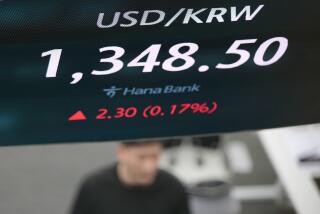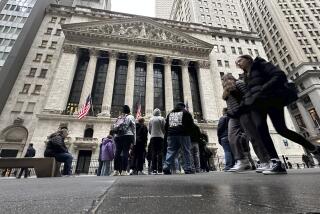S&P; 500 hits record to cap rally
NEW YORK — The new high in the Standard & Poor’s 500 index is a fitting exclamation point for an impressive first quarter in the stock market.
The index of 500 large U.S. companies capped a four-year rally Thursday, recouping all of its losses from the 2008 global financial crisis. The milestone underscored investors’ enthusiasm over the increasingly buoyant U.S. economy.
The S&P; 500 is one of the last major market gauges to hit a new high. Other indexes, including the Dow Jones industrial average, already eclipsed their previous peaks from late 2007.
But the latest record is a more telling barometer because the S&P; 500 is broader than the 30-stock Dow.
That means the S&P; 500 is arguably more important to average investors. Individuals have plunked nearly $480 billion into index funds and exchange-traded funds directly linked to the index, according to Morningstar.
Most areas of the stock market shined during the quarter, which came to a close Thursday because exchanges aren’t trading Friday in observance of Good Friday.
The S&P; 500, which rose 6.34 points Thursday to 1,569.19, rocketed 10% in the first three months of the year. The Dow surged 11.3% to notch its latest record high. And the Nasdaq composite index rose 8.2%.
Small and mid-size stocks fared even better. The Russell 2000 small-stock index jumped 12% while the Standard & Poor’s mid-cap 400 gained 13.1%.
“You’ve seen this gradual and steady melt-up” in share prices, said Patrick O’Hare, chief market analyst at Briefing.com.
Investors seem for the moment to have set aside fear of Washington’s political dysfunction suffocating the incipient economic recovery. Concern about Europe’s debt crisis and China’s economy also have dissipated.
“None of those worst-case scenarios have come to pass,” said Russ Koesterich, chief investment strategist at BlackRock Inc.
VIDEO CHAT: Is now a good time to buy stocks?
Several Wall Street investment firms have boosted their projections for how high the S&P; 500 will climb this year. Wells Fargo Advisors, for example, expects the index to reach 1,575 to 1,625 by year-end, up from its previous estimate of 1,525 to 1,575.
The S&P; 500 is one of the last major indexes to reach a new high. The outlier is the Nasdaq composite, which is well below its peak during the dot-com boom.
However, the S&P; 500 was held back in part by the recent travails of Apple Inc., whose shares fell from $702 in September to as low as $420 in early March.
Stung by stocks’ precipitous fall in the 2008 financial crisis, investors fled equities for the safety of cash and bonds.
But the Federal Reserve’s relentless pumping of billions of dollars into the economy — $85 billion a month — has sent interest rates to historic lows and pushed investors into riskier assets such as stocks.
Stocks have gained about $1.9 trillion, or nearly 11%, in value this year, according to the broad Wilshire 5000 Total Market index. The steady inflows — after five years of collective withdrawals — pushed the Dow to a record March 5.
The question, of course, is whether the 4-year-old bull market can endure. History suggests that it can — but not without heightened turbulence.
Over the last 65 years, this is the seventh bull market to reach its four-year anniversary, according to research firm S&P; Capital IQ. Five of the previous six went on to enjoy a fifth year of gains and three made it to a sixth year.
The average length of the previous six bulls was 74 months. The current S&P; 500 rally, which launched in early March 2009, has lasted nearly 49 months. The longest bull market persisted for nearly a decade during the 1990s dot-com frenzy.
“This bull market still has a ways to go,” said Bruce Simon, chief investment officer for City National Asset Management.
However, even optimists expect stocks to weaken, perhaps significantly, in coming weeks before resuming their longer-term trend upward.
The S&P; hasn’t suffered a notable decline since last fall, a lengthy period in market terms. In each of the last three years, strong advances early in the year gave way to heavy selling in April that dragged the S&P; down between 10% and 19%.
“The pace should begin to slow down,” Koesterich said. “There are a couple speed bumps ahead.”
The automatic spending cuts linked to the federal budget “sequester” threaten to slow the economy. So do tax increases stemming from President Obama’s “fiscal cliff” deal with Congress and the Affordable Care Act healthcare law.
William Dudley, president of the New York Federal Reserve, estimates that the sequester and higher taxes could slice 1.75 percentage points out of gross domestic product this year — but not entirely blunt the economy’s growth.
“Ultimately, though, the drag should abate,” Dudley said in a speech Monday. “When that happens —presumably later this year — the economy should strengthen.”
And though the European debt crisis seemed all but dormant in recent months, a mini-crisis over a bailout of Cyprus’ banking system has reignited concern for the Eurozone currency bloc. Italian political drama has also given investors pause in recent days.
There also are doubts about the durability of corporate earnings. Analysts expect S&P; 500 companies to notch a meager 0.55% profit rise in the first quarter. S&P; Capital IQ expects actual profit will come in stronger, about 4%.
Bulls are encouraged by the plodding but steady improvement in the job market. The economy added 236,000 jobs in February, an unexpectedly strong gain following 119,000 net new jobs in January.
“The labor market has gotten better,” Koesterich said. “We’re seeing a faster pace of job creation than we were for most of the last three years. It’s not off to the races, but there has been a modest improvement in how quickly the economy has been creating jobs.”






